Fractal Geometry and Hindu Temple Architecture
Source: Mandapa: Its Proportion as a tool in Understanding Indian Temple Architecture
Proportion and measurements were the guiding tools for Indian temple construction starting from the 5th century onwards and it continuous even now. Through out the history proportion dominated as a tool, which determined the monuments both spatial arrangements as well as form. The ancient texts, therefore, insist on a high degree of precision in their measurements.
The standard text Mayamata mentions- ”Only if the temple is constructed correctly according to a mathematical system can it be expected to function in harmony with the universe. Only if the measurement of the temple is in every way perfect, there will be perfection in the universe as well.”
Source: A REVIEW STUDY ON ARCHITECTURE OF HINDU TEMPLE

Source: TEMPLE ARCHITECTURE AND SCULPTURE

Source: Symbolism in Hindu Temple Architecture and Fractal Geometry – ‘Thought Behind Form’

Source: TEMPLE ARCHITECTURE AND SCULPTURE
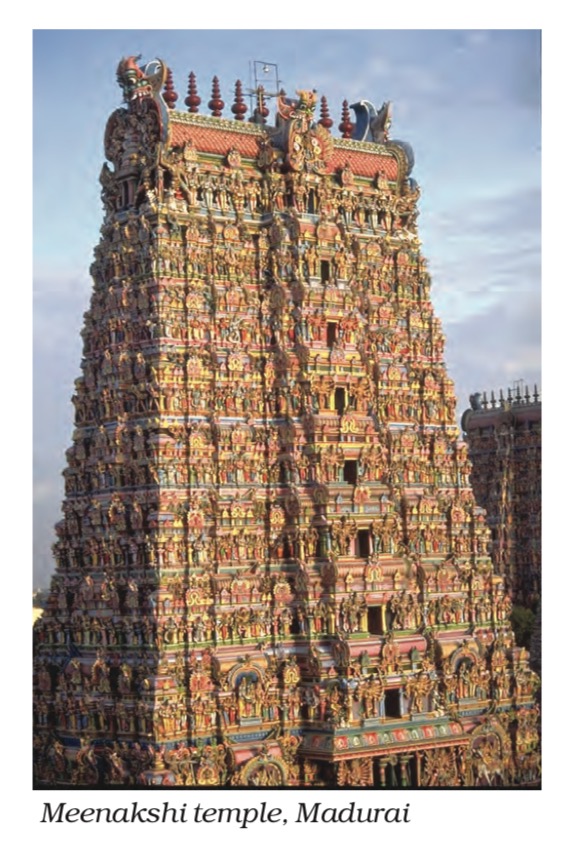
Source: TEMPLE ARCHITECTURE AND SCULPTURE
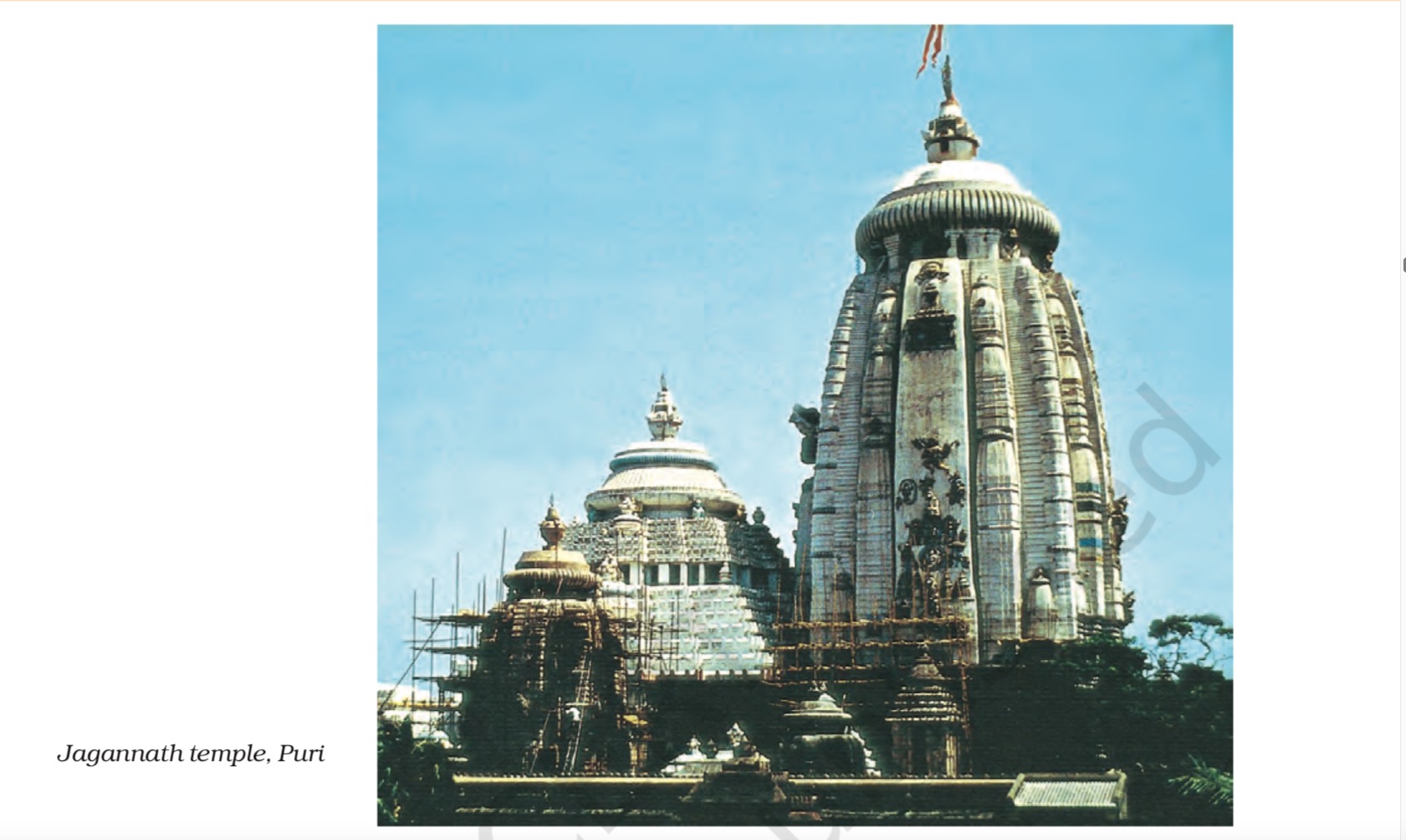
Key Terms
- Fractals
- Cosmology
- Temple Architecture
- Fractal Dimension
- Recursive
- Algorithmically
- Hindu Temples
- Vastu Purush Mandala
- Vastu Shastra
- Shilpa Shastra
- Nagara Style
- Dravidian Style
- Vesara Style
- Kalinga Style
- 64 Yogini Temple Style
- Jain Temple Architecture
- Buddhist Stupa Architecture
- Cellular Automata
- 3D Fractals
- 2D Cellular Automata
- Nine Cell Square
- Nav Grah Yantra
- Sierpinski Carpet
- Box Counting Method
- Biophilic Architecture
- Symbolism
- Square and Circle
- Earth and Heaven
- Squaring the Circle
- Correspondence
- Equivalence
- Symmetry
- As Above, So below
- Cosmic Mirrors
Hindu Temples: Models of a Fractal Universe
Source: Hindu temples: Models of a fractal universe
Hindu philosophy views the cosmos to be holonomic and self-similar in nature. According to ancient architectural tradition, Hindu temples are symbols of models of the cosmos and their form represents the cosmos symbolically.
The procedures and methods used in the construction of Hindu temples bear a striking resemblance to the procedures of computer graphics, including discretization, fractalization and extensive use of recursive procedures, including self-similar iteration. The instructions given in ancient Vastu shastras (texts on architecture) work like general programmes to generate various types of temples.
The paper is an attempt to draw attention to the similarities between the procedures and resulting forms in computer graphics and Hindu temple architecture and to explain the relationship that exists between the form of the temple and the concepts of Hindu philosophy. It is proposed that Hindu temples may be viewed as three dimensional fractal models and that the use of fractal geometry procedures has a special symbolic meaning in the generation of the forms of Hindu temples.
Introduction to the Temple Architecture in the Indian Context
Source: Temples of Odisha- the Geometry of Plan Form
The evolution of temple architecture is marked by a strict adherence to the original ancient models, that were derived from sacred thought which persisted over many centuries. The commencement of the main style of Hindu temple architecture in India dates back to the Mauryan period i.e 3rd century BC, as evident from the archaeological excavation at Sanchi (Madhya Pradesh, temple no.40 and18) and Bairat (Rajastan), (DB Garnayak , 2007) . The Indian Silpasastras recognize three main types of temples known as the Nagara, Dravida and Vesara. Nagara temple belongs to the country from the Himalaya to the Vindhya, Vesara from the Vindhya to the Krishna and the Dravida from the Krishna to the Cape Comorin (DB Garnayak , 2007). An inscription in 1235 A.D in the mukhamandapa of the Amritesvara temple at Holal in Bellary district of Karnataka speaks of the fourth style i.e. Kalinga, in addition to the above three. The Kalinga style of Architecture is explained exclusively in the texts like Bhubana Pradip, Silpa Prakasa, Silpa Ratnakosha etc.
Source: Investigating Architectural Patterns of Indian Traditional Hindu Temples through Visual Analysis Framework
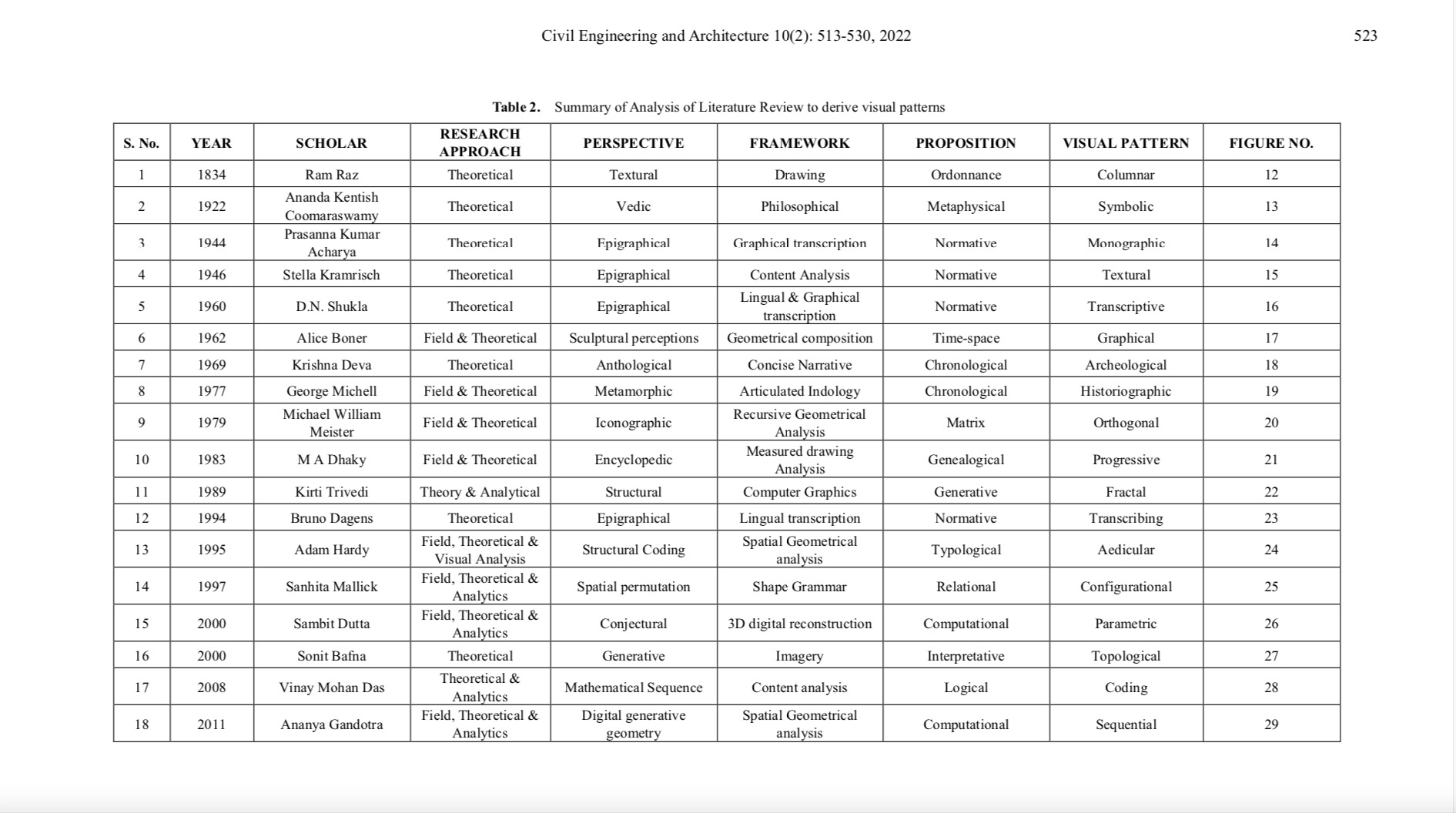
Source: Fractal Geometry as a source of innovative formations in interior design
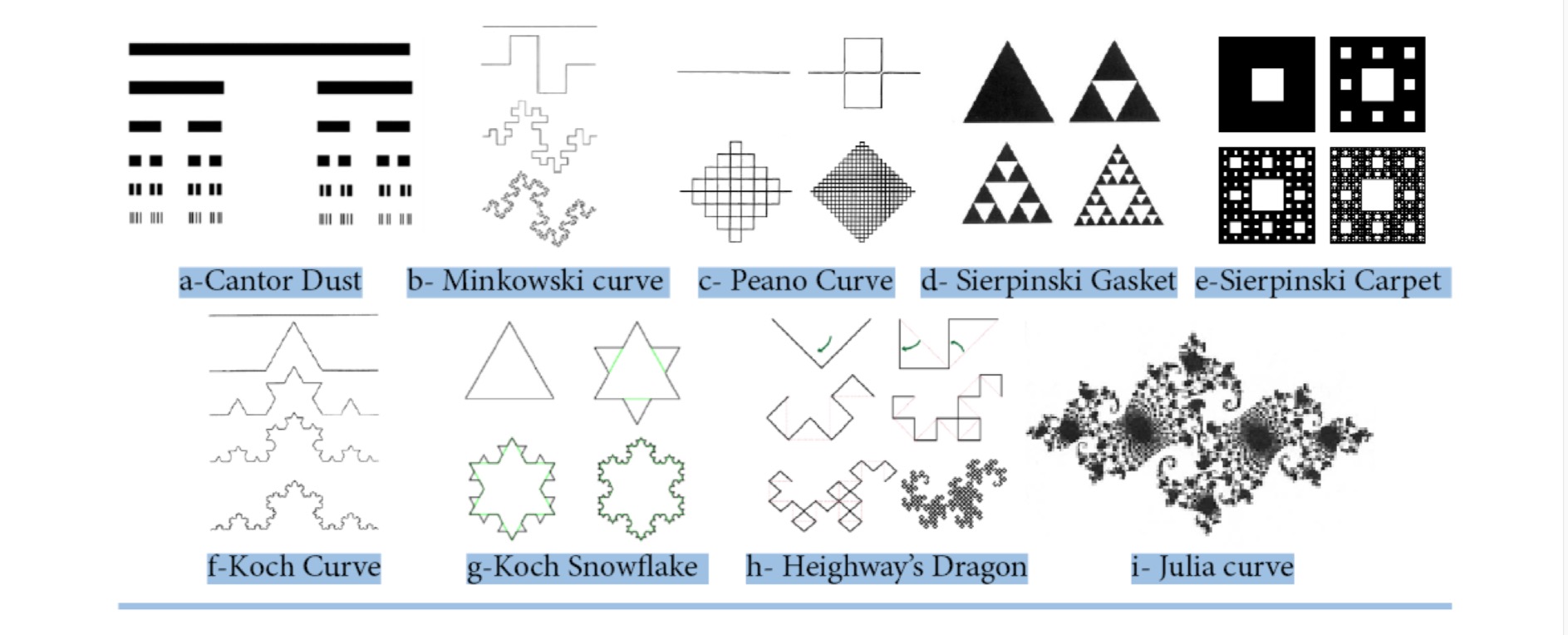
Source: The fractal analysis of architecture: calibrating the box-counting method using scaling coefficient and grid disposition variables
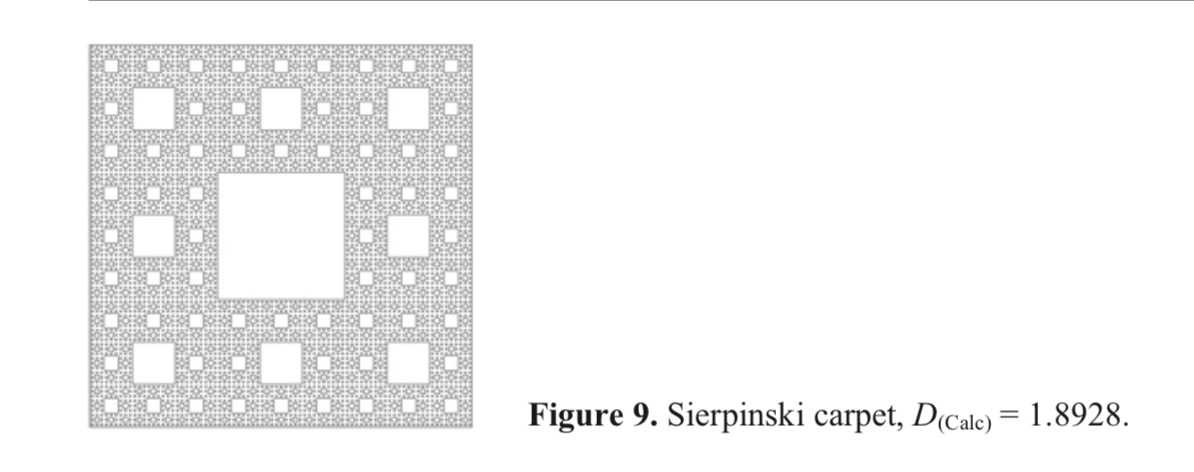
Source: PARAMETRIZING INDIAN KARNATA-DRAVIDA TEMPLE USING GEOMETRY

Vastu purusha mandala
Source: A REVIEW STUDY ON ARCHITECTURE OF HINDU TEMPLE
Layout of a Hindu temple pursues a geometrical design known as vastu-purusha-mandala, the name of which is derived from the three vital components of the design namely Vastu meaning Vaas or a place of dwelling; Purusha, meaning the Universal principle; and Mandala meaning circle. Vastupurushamandala is a mystical diagram referred in Sanskrit as a Yantra. The symmetrical and self-repeating model of a Hindu temple demonstrated in the design is derived from the primary convictions, traditions, myths, fundamentality and mathematical standards. According to Vastupurushamandala, the most sacred and typical template for a Hindu temple is the 8×8 (64) grid Manduka Hindu Temple Floor Plan also referred as Bhekapada and Ajira. The layout displays a vivid saffron centre with intersecting diagonals which according to Hindu philosophy symbolises the Purusha. The axis of the Mandir is created with the aid of the four fundamentally significant directions and thus, a perfect square is created around the axis within the available space. This square which is circumscribed by the Mandala circle and divided into perfect square grids is held sacred. On the other hand, the circle is regarded as human and worldly that can be perceived or noticed in daily life such as the Sun, Moon, rainbow, horizon or water drops. Both the square and the circle support each other. The model is usually seen in large temples while an 81 sub-square grid is observed in ceremonial temple superstructures. Each square within the main square referred as „Pada‟ symbolise a specific element that can be in the form of a deity, an apsara or a spirit. The primary or the innermost square/s of the 64 grid model called Brahma Padas is dedicated to Brahman. The Garbhagruha or centre of the house situated in the Brahma Padas houses the main deity. The outer concentric layer to Brahma Padas is the Devika Padas signifying facets of Devas or Gods which is again surrounded by the next layer, the Manusha Padas, with the ambulatory. The devotees circumambulate clockwise to perform Parikrama in the Manusha Padas with Devika Padas in the inner side and the Paishachika Padas, symbolising facets of Asuras and evils, on the outer side forming the last concentric square. The three outer Padas in larger temples generally adorn inspirational paintings, carvings and images with the wall reliefs and images of different temples depicting legends from different Hindu Epics and Vedic stories. Illustrations of artha, kama, dharma and moksha can be found in the embellished carvings and images adorning the walls, ceiling and pillars of the temples.
Source: A REVIEW STUDY ON ARCHITECTURE OF HINDU TEMPLE
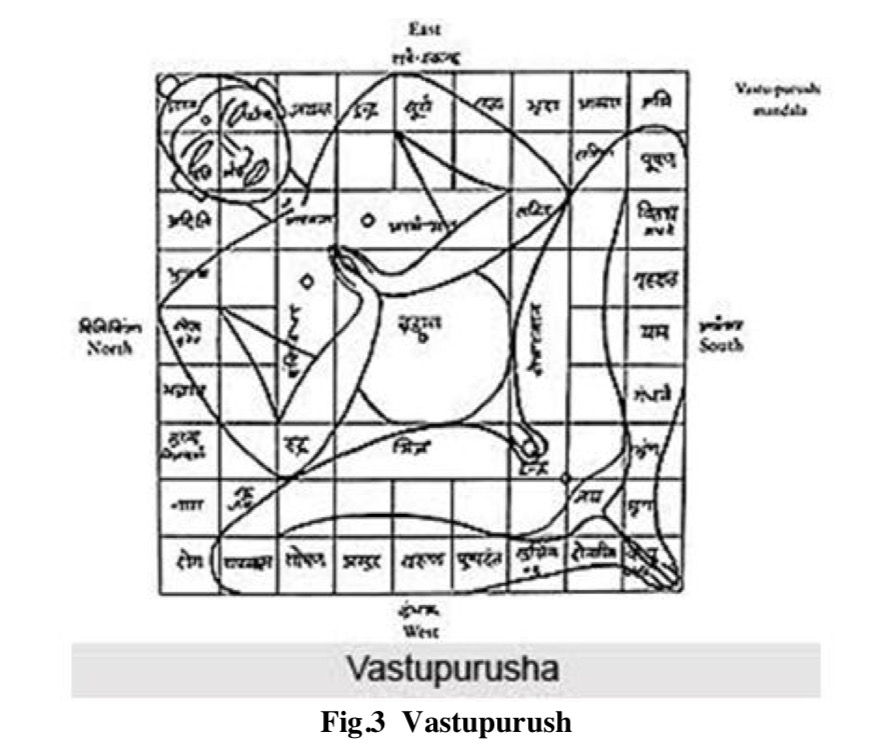
Source: VASTU PURUSHA MANDALA- A HUMAN ECOLOGICAL FRAMEWORK FOR DESIGNING LIVING ENVIRONMENTS
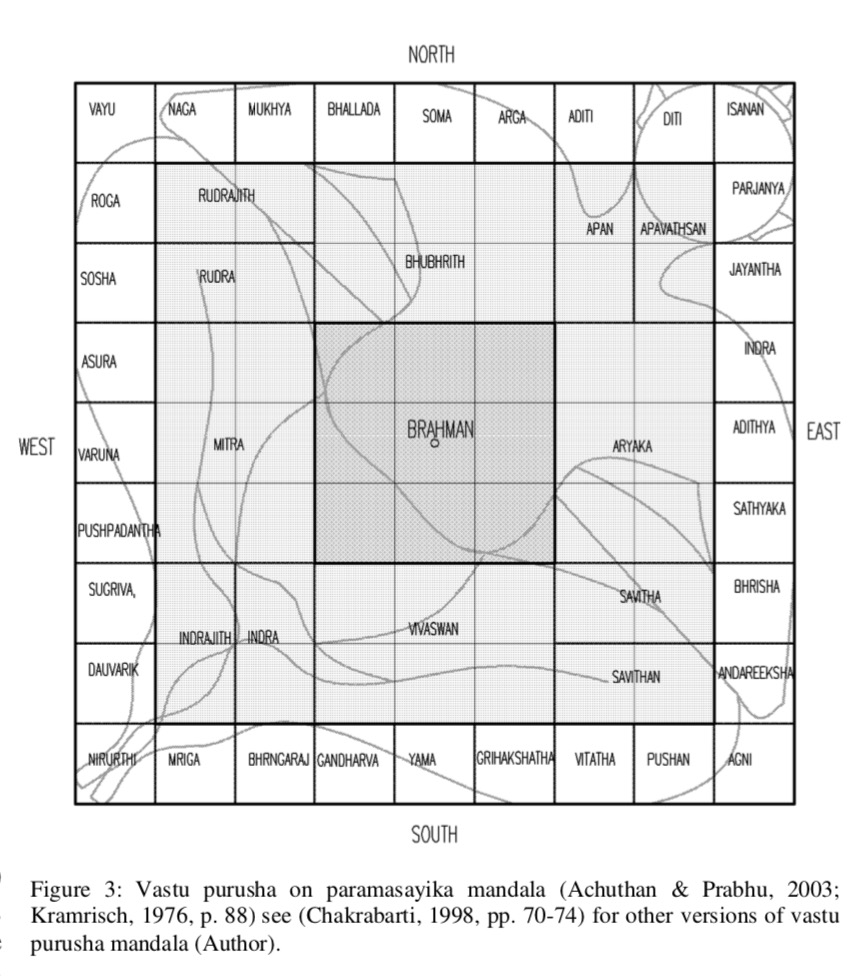
Source: Space and Cosmology in the Hindu Temple

Source: Exploring Ancient Architectural Designs with Cellular Automata

Source: Fractal geometry as the synthesis of Hindu cosmology in Kandariya Mahadev temple, Khajuraho

Source: Fractal geometry as the synthesis of Hindu cosmology in Kandariya Mahadev temple, Khajuraho
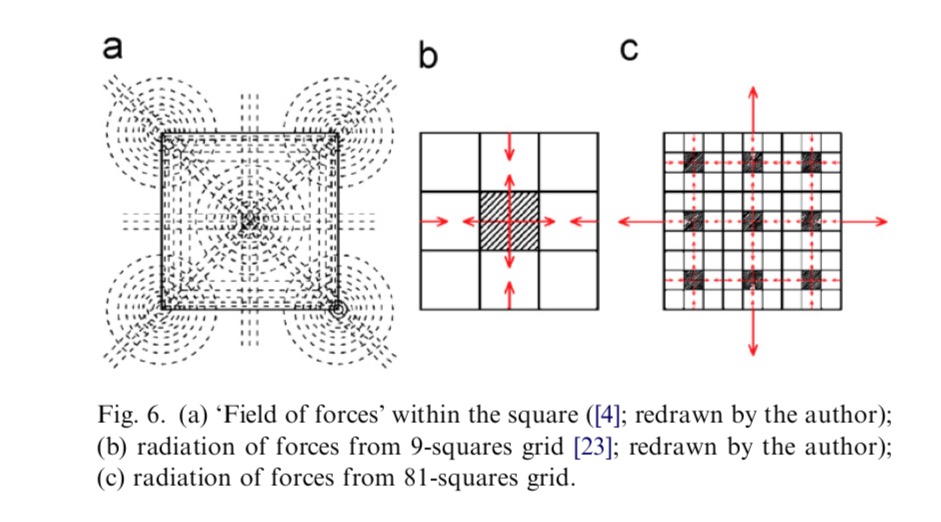
Source: Fractal geometry as the synthesis of Hindu cosmology in Kandariya Mahadev temple, Khajuraho

Source: Fractal geometry as the synthesis of Hindu cosmology in Kandariya Mahadev temple, Khajuraho
According to Hindu philosophy, the main goal of man’s life is to achieve the ultimate liberation from the illusionary world where he suffers from his endless rebirth. Krishna says in Bhagavad Gita,9 if man worships, devotes and meditates to the manifested form of the wholeness of infinity, and sees the truth of its manifestation; he will surpass the confusion of the never-ending cycles of rebirth in this physical world, and finally will assimilate with the God. 10 Hindu calls it moksha.11 It brings the ultimate peace and harmony in man’s life. But how one, from the physical world, can practice to realize this ultimate truth of the creation? Brihatsamhita12 and Sthapatyaveda13 give the solution as the temple which should act as the microcosm of the cosmos [9]. It should be the bridge for the man of physical world to the God of divine world [10].
To connect the physical world with the divine world and to reflect the truth of creation, the layout of cosmos was copied graphically in the foundation of temple. Here, a mythical incident was interwoven where a formless being covered the sky and was, immediately, arrested down to the earth by the creator Brahma and other gods. This supernatural fact was depicted graphically by vastu purusha mandala, where vastu refers to physical environment, purusha refers to energy, power or cosmic being, and mandala is the diagram or chart. Central portion of the mandala represents the place of Brahma and other portions symbolize the other gods according to their capability. By laying down this metaphysical diagram in the foundation, various supernatural forces are captured beneath the temple whereas its centre is the source of cosmic energies. The basic shape of the vastu purusha mandala is a square which represents the earth [11]. Its four sides depict the four cardinal directions. It also symbolizes the order, the completeness of endless life and the perfectness of life and death [10]. According to Hindu philosophy, our mundane life is controlled by the number four—four castes, four stages of life, four great epochs or mahayugas, four heads of Brahma, the four Vedas etc. [12].
There are various types of vastu purusha mandala, which are nothing but the squares grids, produced from the basic shape; namely, a square which is known as sakala mandala. Each smaller square within the grid is called one pada. The number of pada may vary from 1, 4, 9, 16, 25 and so on 1024, where it follows the geometric progression of 1, 2, 3, 4, 5,…..,32 of common ratio 2. The mandala having even numbers of pada in its grid known as yugma squares mandala whereas the mandala, having odd numbers of pada known as ayugma squares mandala. Vastu purusha mandala is also known as different distinctive names according to the numbers of pada within the grid. The mandala having 1,4,9,16,25 and 36 numbers of pada within the grid are known as sakala mandala, pechaka mandala, pitah mandala, mahapitah mandala, manduka chandita mandala and para- masayika mandala, respectively14.
Source: Fractal geometry as the synthesis of Hindu cosmology in Kandariya Mahadev temple, Khajuraho

Source: Fractal geometry as the synthesis of Hindu cosmology in Kandariya Mahadev temple, Khajuraho
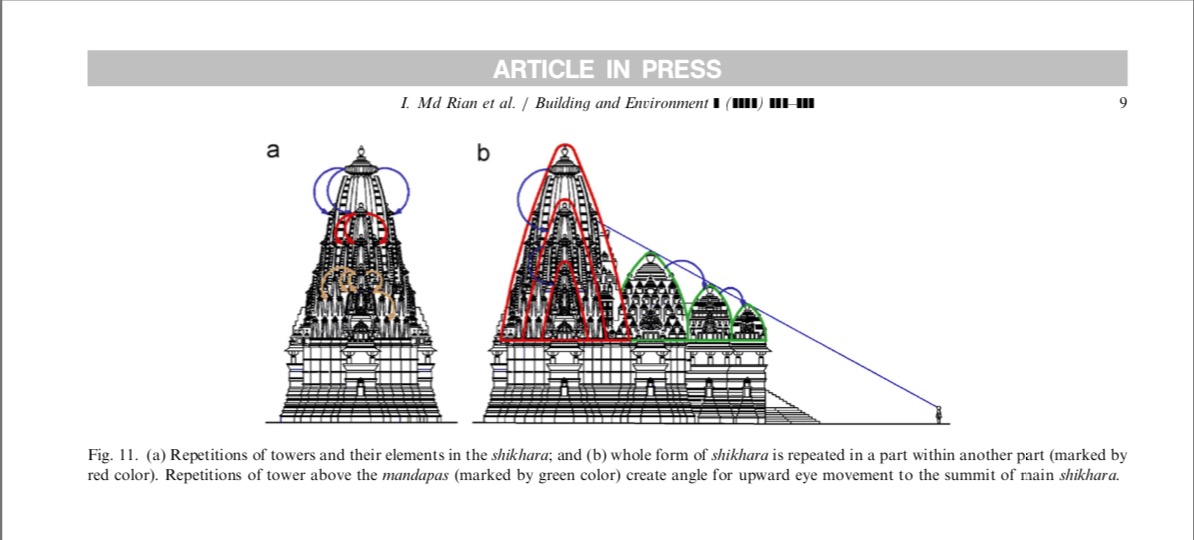
Source: Fractal geometry as the synthesis of Hindu cosmology in Kandariya Mahadev temple, Khajuraho

Source: Fractal geometry as the synthesis of Hindu cosmology in Kandariya Mahadev temple, Khajuraho

FRACTAL DESIGN, ARCHITECTURE AND ART IN HUMAN HISTORY
Source: Working with Fractals
Fractals have permeated cultures spanning across many centuries and continents, classical art and vernacular architecture from the column capitals of ancient Greece, Egyptian, Aztec, Incan civilisations, the art of Ancient Mayans, Islamic and Hindu temples, Angkor Wat in Cambodia, the Eifel Tower in Paris, and the structures of Santiago Calatrava. Fractals are also evident in such well known works as those of Botticelli, Vincent van Gogh, and Jackson Pollock. Their visual properties were also explored by mathematicians when Benoit Mandelbrot published The Fractal Geometry of Nature (1982) in which he catalogued nature’s statistical fractals and discussed them using mathematical methods for their replication.
Fractals constitute a central component of human daily experience of the environment (Taylor & Spehar, 2016). While extensive research has documented the negative effects of environments that do not have
a complement of rich experiential aesthetic variety (Mehaffy & Salingaros, 2013), their proliferation in art and design has continued to grow and diversify, creating architecture, interiors and products designed for human needs (Taylor & Spehar, 2016). Over the past two decades, interdisciplinary teams have confirmed that the aesthetic qualities of nature’s fractal patterns can induce striking effects on health.1
PARAMETERS OF FRACTAL PREFERENCE
Source: Working with Fractals: For the Love of Fractals
The universal preference for ‘statistical’ fractals peaks at low to moderate degree of complexity, while universal preference for ‘exact’ fractals peaks at a higher complexity. The high level of symmetry in exact fractals enables greater tolerance for visual complexity compared to statistical fractals (Abboushi et al., 2019). Four factors influence complexity in exact fractals:
1. Fractal dimension (D)
2. Symmetry
3. Recursion
4. Number of elements introduced at each recursion
Fractal dimension.
The Euclidean simplicity and symmetry of exact fractals increases tolerance and peak preference for medium-high complexity exact fractals (D= 1.5–1.7) (Abboushi et al., 2019). Medium- high exact fractals can enhance visual preference and mood, particularly in less complex Euclidean interior spaces (Abboushi et al., 2019; Taylor et al., 2018).
When complex fractal patterns are experienced within a low-complexity interior space, the visual preference can shift to those available higher D values (1.5 to 1.7, medium-high range), suggesting that a low complexity environment enables a tolerance and preference for higher complexity statistical fractals such as found in artworks or casted light patterns unique within that space (Abboushi et al., 2019). A good example of this scenario is museums with an abundance of geometrical rooms and white walls adorned with highly complex artworks that captivate.
Symmetry.
Patterns with symmetry and geometry, such as common among exact fractals, can be visually appealing as they balance interest and comprehensibility. Mirror symmetry is generally considered one of the most predictive factors when judging whether a geometric pattern is ‘beautiful’. A lack of radial and mirror symmetry can be overcome by including more recursion and higher fractal dimensionality.
The orderliness of exact fractals allows a pattern to approach the maximum use of space at a particular dimension while retaining its elegance. Patterned tiles and carpet, wall coverings and textiles, artefacts and ornaments found in many cultures (Eglash, 2002) are evidence of this spatial orderliness and symmetry.
Recursion.
Fractals generated by a finite subdivision rule bear a striking resemblance to both nature and human ornament. In mathematics, the finite subdivision rule is a recursive way of dividing a polygon or other two-dimensional shape into smaller and smaller pieces. In a sense, subdivision rules are generalisations of regular exact fractals. Instead of repeating exactly the same design over and over, they have slight variations in each stage, allowing a richer structure while maintaining the elegant style of fractals (Cannon, et al., 2001).
Source: The application of complexity theory and Fractals in architecture, urban planning and design
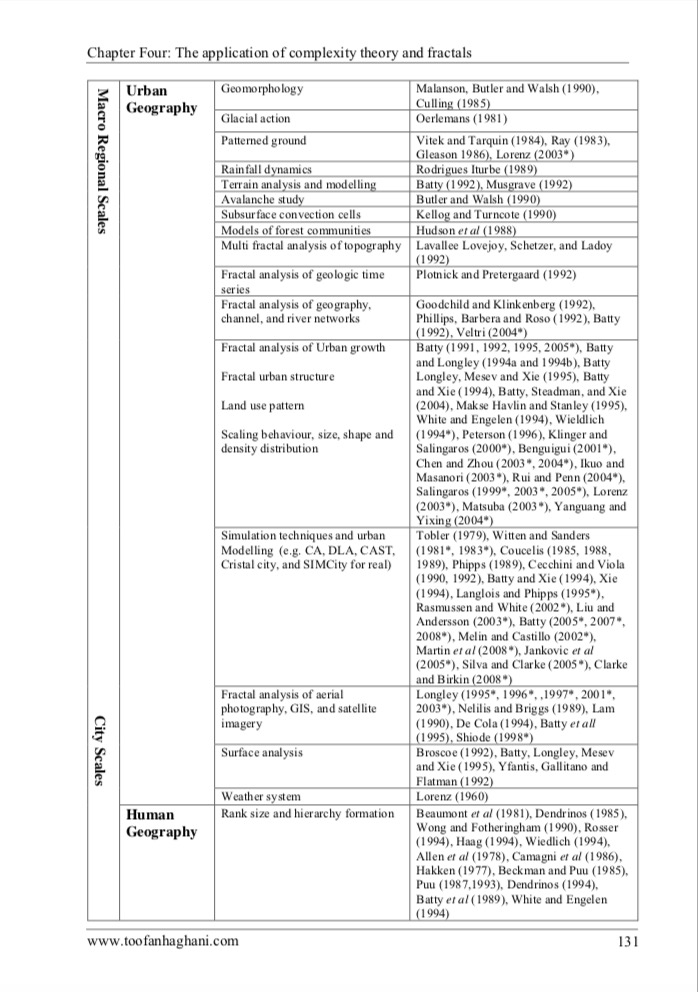
Source: The application of complexity theory and Fractals in architecture, urban planning and design
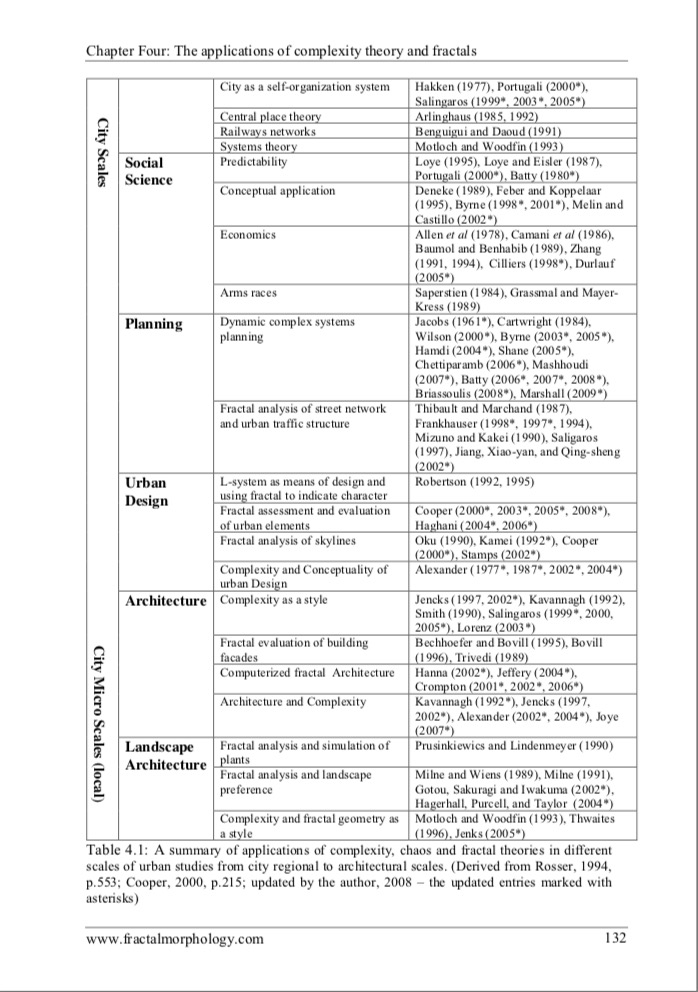
My Related Posts
Interconnected Pythagorean Triples using Central Squares Theory
Indra’s Net: On Interconnectedness
Maha Vakyas: Great Aphorisms in Vedanta
Growth and Form in Nature: Power Laws and Fractals
Consciousness of Cosmos: A Fractal, Recursive, Holographic Universe
Mind, Consciousness and Quantum Entanglement
Meta Integral Theories: Integral Theory, Critical Realism, and Complex Thought
From Systems to Complex Systems
Key Sources of Research:
Role of Fractal Geometry in Indian Hindu Temple Architecture
Dhrubajyoti Sardar
M.Arch Scholar
Architecture & Planning Department, IIT Roorkee
Roorkee, Uttarakhand, India
S. Y. Kulkarni
Professor & Former Head Architecture & Planning Department, IIT Roorkee Roorkee, Uttarakhand, India
International Journal of Engineering Research & Technology (IJERT)
ISSN: 2278-0181 Vol. 4 Issue 05, May-2015
Physical Fractals: Self Similarity and Square-Integratibility
Akhlesh Lakhtakia
Penn State
Speculations in Science and Technology 18, 153-156, 1995
The Hindu Temple as a Model of Fractal Cosmology – Forecasting Architecture with Recursive Instruction
Data is Nature
Monday, 6 April 2015
http://www.dataisnature.com/?p=2138
Dancing Architecture: The parallel evolution of Bharatanātyam and South Indian Architecture
Kavitha Jayakrishnan
University of Waterloo
Master of Architecture Thesis 2011
https://uwspace.uwaterloo.ca/bitstream/handle/10012/6356/Jayakrishnan_Kavitha.pdf?sequence=1
Building Science of Indian Temple Architecture
Shweta Vardia
shwetavardia@gmail.com
2008 MS Thesis
Universidade do Minho, Portugal
The Fractal Structure of Hindu Temples
Fractal Enlightenment
Fractal Geometry And Self-Similarity In Architecture: An Overview Across The Centuries
Nicoletta Sala
Academy o f Architecture o f Mendrisio, University o f Italian Switzerland Largo Bernasconi CH- 6850 Mendrisio
Switzerland
E-mail: nsala @ arch.unisLch
Shapes, Patterns and Meanings in Indian Temple Architecture
Tanisha Dutta*, V. S. Adane
Department of Architecture and Planning, Visvesvaraya National Institute of Technology Nagpur, India *Corresponding author: ar.tanisha.dd@gmail.com
Received July 17, 2018; Revised August 20, 2018; Accepted November 05, 2018
American Journal of Civil Engineering and Architecture, 2018, Vol. 6, No. 5, 206-215
Available online at http://pubs.sciepub.com/ajcea/6/5/6 ©Science and Education Publishing DOI:10.12691/ajcea-6-5-6
Click to access ajcea-6-5-6.pdf
Hindu Temple: Models of a Fractal Universe.
Trivedi, K. (1993).
International Seminar on Mayonic Science and Technology,
243-258.
The Visual Computer 5, 243–258 (1989). https://doi.org/10.1007/BF02153753
https://link.springer.com/article/10.1007/BF02153753#citeas
Click to access Hindu_Temple_Models.pdf
Fractal geometry as the synthesis of Hindu cosmology in Kandariya Mahadev temple, Khajuraho
IasefMd Riana Jin-HoParka HyungUk Ahna DongkukChangb
aDepartment of Architecture, Inha University, South Korea
bDepartment of Architecture, Chosun University, South Korea
Received 4 May 2006, Revised 21 July 2006, Accepted 15 January 2007, Available online 23 April 2007.
Building and Environment
Volume 42, Issue 12, December 2007, Pages 4093-4107
https://www.sciencedirect.com/science/article/abs/pii/S0360132307000273
Symbolism in Hindu Temple
Architecture through Fractal Geoemtry- ‘Thought Behind Form’.
Dutta, T., & V.S.Adane. (2014).
International Journal of Science and Research (IJSR), 489-497.
Fractal geometry and architecture: some interesting connections
N. Sala
Accademia di Architettura, Università della Svizzera italiana, Mendrisio, Switzerland
Eco-Architecture: Harmonisation between Architecture and Nature 163
Temples of Odisha- the Geometry of Plan Form
Rinku Parashar
Assistant Professor Department of Architecture Engineering NIT, Raipur, 492010, India
Dr Abir Bandyopadhyay
Professor & Head Department of Architecture Engineering NIT, Raipur, 492010, India
IJIRST –International Journal for Innovative Research in Science & Technology| Volume 2 | Issue 10 | March 2016 ISSN (online): 2349-6010
Click to access IJIRSTV2I10036.pdf
Shape and geometrical study of fractal cosmology through Orissan Temple architecture
Partha Sarathi Mishra
january 2013
“Investigating Architectural Patterns of Indian Traditional Hindu Temples through Visual Analysis Framework,”
Aditya Kumar Singh, Vinay Mohan Das, Yogesh Kumar Garg, Mohammad Arif Kamal ,
Civil Engineering and Architecture, Vol. 10, No. 2, pp. 513-530, 2022.
DOI: 10.13189/cea.2022.100211.
“Infinite Sequences in the Constructive Geometry Of Tenth-Century Hindu Temple Superstructures”,
Datta, S.,
School of Architecture and Building Deakin University 1, Gheringhap Street Geelong VIC 3219 AUSTRALIA
sdatta@deakin.edu.au
Nexus Network Journal – Vol.12, No. 3, 2010 471 – 483
DOI 10.1007/s00004-010-0038-0; published online 15 September 2010
Kim Williams Books, Turin
https://link.springer.com/article/10.1007/s00004-010-0038-0
Evolution and Interconnection: Geometry in Early Temple Architecture
- S. Datta
- Published 2021
DOI:10.1007/978-3-030-57907-4_11
Corpus ID: 238053244
Fractal Geometry as a source of innovative formations in interior design
Omniah Bahaa Ibrahim
Teaching Assistant, at Faculty of Applied Arts, Interior Design & Furniture Department, Helwan University, Giza, Egypt
DOI: 10.21608/jdsaa.2021.42275.1075
Fractal Geometry and Architecture Design: Case Study Review
Xiaoshu Lu1,2, Derek Clements-Croome3, Martti Viljanen1
1Department of Civil and Structural Engineering, School of Engineering, Aalto University, PO Box 12100, FIN-02150, Espoo, Finland
E-mail: xiaoshu@cc.hut.fi
2Finnish Institute of Occupational Health, Finland
3School of Construction Management and Engineering, Whiteknights, University of Reading, PO Box 219, Reading RG6 6AW, UK
Click to access 2_CMSIM_2012_Lu_clements_Croome_viljanen_2_311-322.pdf
A review of the fractal geometry in structural elements
Aman Upadhayay, Dr. Savita Maru
Department of Civil Engineering, Ujjain Engineering College, India
International Journal of Advanced Engineering Research and Science (IJAERS)
Peer-Reviewed Journal
ISSN: 2349-6495(P) | 2456-1908(O)
Vol-8, Issue-7; Jul, 2021
Journal Home Page Available: https://ijaers.com/
Article DOI: https://dx.doi.org/10.22161/ijaers.87.3
The fractal analysis of architecture: calibrating the box-counting method using scaling coefficient and grid disposition variables
Michael J Ostwald
School of Architecture and Built Environment, University of Newcastle, University Drive, Callaghan, NSW 2308, Australia;
email: Michael.Ostwald@newcastle.edu.au
Received 15 July 2011; in revised form 21 March 2012
Environment and Planning B: Planning and Design 2013, volume 40, pages 644 – 663
doi:10.1068/b38124
Mandapa: Its Proportion as a tool in Understanding Indian Temple Architecture
Ragima N Ramachandran
International Journal of Scientific & Engineering Research Volume 10, Issue 7, July-2019 2104 ISSN 2229-5518
African Fractals
MODERN COMPUTING AND INDIGENOUS DESIGN
RON EGLASH
Book
PARAMETRIZING INDIAN KARNATA-DRAVIDA TEMPLE USING GEOMETRY
SRUSHTI GOUD
BMS School of Architecture, Yelahanka, Bangalore, India
goudsrushti@gmail.com
Click to access ascaad2016_042.pdf
A REVIEW STUDY ON ARCHITECTURE OF HINDU TEMPLE
PRATHAMESH GURME1,PROF. UDAY PATIL2
1UG SCHOLAR,2HEAD OF DEPARTMENT, DEPARTMENT OF CIVIL ENGINEERING BHARATI VIDHYAPEETH’S COLLEGE OF ENGINEERING , LAVALE , PUNE , INDIA
INTERNATIONAL JOURNAL FOR RESEARCH & DEVELOPMENT IN TECHNOLOGY
Exploring Ancient Architectural Designs with Cellular Automata
Hokky Situngkir
[hokky.situngkir@surya.ac.id]
Dept. Computational Sociology, Bandung Fe Institute Center for Complexity Studies in Surya University
BFI Working Paper Series WP-9-2010
WORKING WITH FRACTALS
A RESOURCE FOR PRACTITIONERS OF BIOPHILIC DESIGN
A PROJECT OF THE EUROPEAN ‘COST RESTORE ACTION’
PREPARED BY RITA TROMBIN
The application of complexity theory and Fractals
in architecture, urban planning and design
Chapters
The influence of traditional Indian architecture in Balkrishna Doshi’s IIM Complex at Bangalore: A comparative analysis using fractal dimensions and lacunarity
,Mario Lodeweik LIONAR, (Ph.D. Program of Architecture, Institute of Natural Sciences, Bursa Uludağ University, Bursa, Turkey)
Özgür Mehmet EDİZ (Department of Architecture, Faculty of Architecture, Bursa Uludağ University, Bursa, Turkey)
A|Z ITU Mimarlık Fakültesi Dergisi
DOI: 10.5505/itujfa.2021.80388
https://search.trdizin.gov.tr/yayin/detay/503974/
The Dual Language of Geometry in Gothic Architecture: The Symbolic Message of Euclidian Geometry versus the Visual Dialogue of Fractal Geometry
Nelly Shafik Ramzy
Sinai University
Peregrinations: Journal of Medieval Art and Architecture
Volume 5 Issue 2 2015
PRINCIPLES OF FRACTAL GEOMETRY AND APPLICATIONS IN ARCHITECTURE AND CIVIL ENGINEERING
Anton Vrdoljak, M.Sc.
Faculty of Civil Engineering, University of Mostar, anton.vrdoljak@gf.sum.ba Kristina Miletić, B.Sc.(Math.)
Faculty of Civil Engineering, University of Mostar, kristina.miletic@gf.sum.ba
Number 17, June 2019.
https://hrcak.srce.hr/file/324620
SHAPE AND GEOMETRY OF ORISSAN TEMPLE ARCHITECTURE
Authors: Mishra, Partha Sarathi
MS Thesis, IITR 2012
http://localhost:8081/xmlui/handle/123456789/2017
http://shodhbhagirathi.iitr.ac.in:8081/jspui/handle/123456789/2017
The Shape of Cities: Geometry, Morphology, Complexity and Form
Chapter in book Fractal Cities
WHOLENESS, VISUAL COMPLEXITY AND MATERIALITY:
A Comparative Analysis Using Fractal Dimension Analysis And Mirror Of The Self-Test In The Case Of Material Imitations.
author | FILIP KINNERT supervisor | doc. PhDr. MARTIN HORÁČEK Ph.D.
Vastu Purusha Mandala – A human ecological framework for designing living environments.
Venugopal, Jayadevi
In Jetty, C, Chandra, B, Bhashyam, A, & Prabhakara, R (Eds.) Proceedings of International Conference on Advances in Architecture and Civil Engineering (AARCV 2012), Volume 2.
Bonfring, India, pp. 870-877.
Rediscovering the Hindu Temple:
The Sacred Architecture and Urbanism of India
Vinayak Bharne and Krupali Krusche
Book, ISBN (10): 1-4438-4137-4, ISBN (13): 978-1-4438-4137-5
Borobudur was Built Algorithmically
Hokky Situngkir
[hs@compsoc.bandungfe.net]
Dept. Computational Sociology Bandung Fe Institute
TEMPLE ARCHITECTURE AND SCULPTURE
NCERT
Fractal Cities: A Geometry of Form and Function,
Batty, M., Longly, P., 1994,
Academic Press, San Diego.
Book
Space and Cosmology in the Hindu Temple
Subhash Kak
Presented at Vaastu Kaushal: International Symposium on Science and Technology in Ancient Indian Monuments, New Delhi, November 16-17, 2002.
Gender and space in temple architecture
D. Midhila
midhilachandra@gmail.com
Hindustan Institute of Technology and Sciences, Vijayawada, Andhra Pradesh
Dr. R. V. Nagarajan
rvnagarajan@hindustanuniv.ac.in
Hindustan Institute of Technology and Sciences, Padur, Chennai, Tamilnadu
International Journal of Advance Research, Ideas and Innovations in Technology
2020
The Role of Five Elements of Nature In Temple Architecture
Ar. Snigdha Chaudhary
International Journal of Scientific & Engineering Research Volume 8, Issue 7, July-2017 1149 ISSN 2229-5518
Trends in Fractal Dimension in Laxman and Kandariya Mahadev Temples, Khajuraho
Tanisha Dutta1,* and Vinayak S. Adane2
1Phd Research Scholar, Department of Architecture and Planning, Visvesvaraya National Institute of Technology, Nagpur- 440010, India.
2Professor, Department of Architecture and Planning, Visvesvaraya National Institute of Technology, Nagpur- 440010, India. (*Corresponding author)
nternational Journal of Applied Engineering Research ISSN 0973-4562 Volume 13, Number 3 (2018) pp. 1728-1741
© Research India Publications. http://www.ripublication.com
Hindu Temple Fractals
William J Jackson
https://www.academia.edu/347639/Hindu_Temple_Fractals
Indian Architectural Theory: Contemporary Uses of Vastu Vidya
Vibhuti Chakrabarti
Oxford University Press (1999)
ISBN 0195650417
Maṇḍala in Architecture: Symbolism and Significance for Contemporary Design Education in India
Navin Piplani Ansal University India
Tejwant Singh Brar Ansal University India
IAFOR Journal of Education: Studies in Education
Volume 8 – Issue 4 – 2020
The Intriguing Temples of the 64 Yoginis
2022
